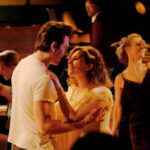For those familiar with my online presence, particularly on platforms like Twitter, or those who have followed my blog over time, it’s likely known that I spent my earlier years deeply immersed in the world of competitive salsa dancing. My dance journey began with classical training in childhood, evolving into various Latin styles including tango and merengue, before specializing in salsa. This passion led me to compete in dance tournaments and teach the intricate art of salsa. While I still enjoy dancing, the demands of pursuing a PhD shifted my focus away from competitive dance. (By the way, the image above captures two spontaneous salsa dancers in Granville Street, Vancouver, who graciously allowed me to photograph their impromptu performance.)
This background made me particularly eager to delve into Salsa Dancing into the Social Sciences: Research in an Age of Info-Glut by Kristen Luker. I approached this book with the anticipation of discovering a unique intersection between the dynamic movements of salsa and the often intricate processes of social science research.
While “Salsa Dancing into the Social Sciences” didn’t entirely align with my preconceived notions of a direct, metaphorical link between salsa steps and sociological concepts, it proved to be a valuable and insightful read. My initial expectation, perhaps influenced by my own background, was to find explicit parallels – swaying as a metaphor for theoretical flexibility, footwork representing methodological rigor, or spins illustrating innovative thinking in research. However, Luker’s approach is more nuanced, focusing less on literal dance metaphors and more on the spirit of salsa – its fluidity, adaptability, and engagement – as a lens through which to view the research process.
Despite this divergence from my initial expectations, the book’s strength lies in its comprehensive and accessible explanation of research methods, particularly within the qualitative and historical-comparative domains. Luker masterfully connects the mechanics of research with the broader research process, offering practical guidance on conducting social science research. She emphasizes critical skills and practices, encapsulated in memorable advice nuggets.
The book is rich with “pearls of wisdom,” as I noted on Twitter, such as the importance of identifying a “nodal point” in research, building rapport with reference librarians, and maintaining meticulous records. Luker’s concept of “Harvarding” – effectively utilizing library resources – is a testament to her pragmatic approach to research. While her methodological focus leans towards qualitative approaches, the underlying analytical thinking reflects a scholar well-versed in both qualitative and quantitative traditions. The essence of a “salsa-dancing social scientist,” as I interpreted it, isn’t about literal dance moves in research, but about embodying a holistic approach, moving “deftly and nimbly” across various facets of the research journey.
Luker’s writing style is conversational and engaging, reminiscent of Bolker’s approachable style, yet grounded in the methodological rigor of authors like Dunleavy, and incorporating practical exercises akin to Sternberg’s work. This blend makes “Salsa Dancing into the Social Sciences” particularly valuable for doctoral students, perhaps as a stimulating read during academic breaks, followed by a chapter-by-chapter engagement with the exercises provided.
In conclusion, despite my initial, perhaps skewed, expectations of explicit salsa-dancing metaphors, Kristen Luker’s book is a highly recommended resource, especially for those in the social sciences. It provides a readable and insightful guide to research methods, predominantly qualitative but with quantitative undercurrents. For doctoral students and researchers seeking a practical and engaging approach to mastering research methodologies, “Salsa Dancing into the Social Sciences” offers a refreshing and valuable perspective. It encourages a dynamic and adaptable approach to research, much like the dance form it playfully references, making the often-daunting world of academic inquiry feel a little more like a captivating dance.

